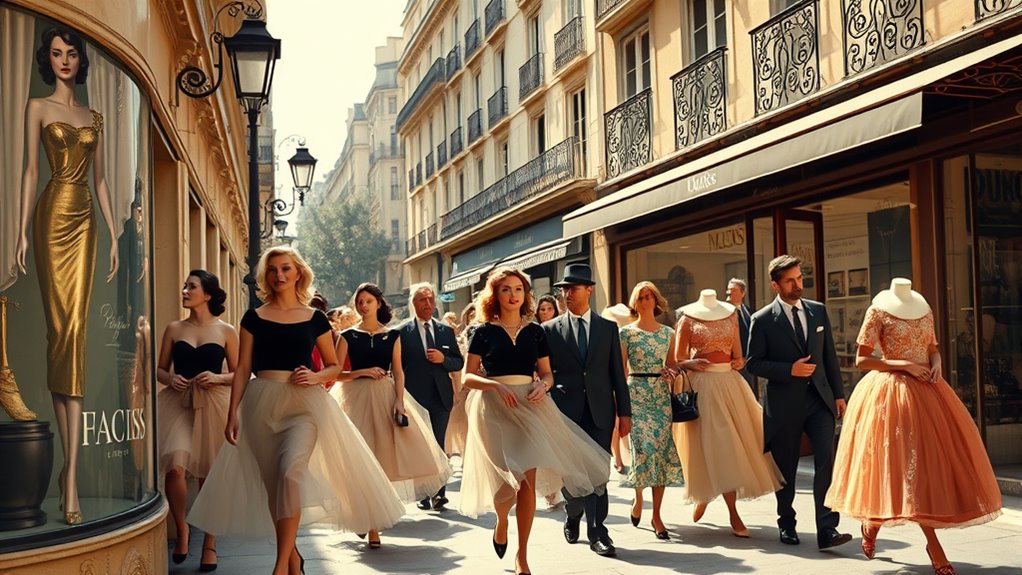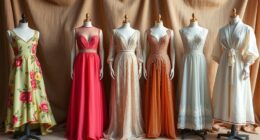In 1950s Paris, haute couture reached its golden age, symbolizing elegance, innovation, and exclusivity. You witness master craftsmanship with detailed embroidery and custom tailoring that turn clothes into wearable art. Designers like Christian Dior revolutionized fashion with bold new styles, blending traditional techniques with innovative textiles. This era elevated couture to an art form that shaped industry standards. To discover how these creations continue to influence fashion today, explore how Paris defined this iconic period.
Key Takeaways
- The 1950s marked a peak in haute couture, showcasing exquisite craftsmanship, innovative designs, and luxurious fabrics in Paris.
- Christian Dior’s “New Look” revolutionized femininity with structured, elegant silhouettes, defining the era’s fashion trends.
- Couture garments were meticulously handcrafted, tailored to individual measurements, emphasizing exclusivity and social status.
- Technological advances introduced new textiles and embellishments, enabling bold textures, vibrant colors, and trendsetting designs.
- Paris during this decade became the global fashion capital, elevating haute couture to an artistic and cultural symbol of luxury.

In 1950s Paris, haute couture was more than just fashion—it was a symbol of elegance, innovation, and social status. You could see it in the meticulous details and exquisite fabrics that defined the era’s most celebrated creations. As a wearer, you’re not just donning a dress; you’re embodying a tradition rooted in luxury craftsmanship. Every stitch, every cut, and every embellishment reflects the skill of master artisans dedicated to their craft. This level of craftsmanship elevates couture beyond mere clothing, transforming it into wearable art that communicates sophistication and exclusivity.
In 1950s Paris, haute couture embodied elegance, innovation, and craftsmanship—transforming fashion into timeless wearable art.
During this period, fashion innovation was at its peak. Designers pushed boundaries, blending traditional techniques with new ideas that challenged conventions. You might have admired the bold, structured silhouettes championed by Christian Dior’s revolutionary “New Look,” which redefined femininity with its cinched waist and full skirt. These designs weren’t just trends—they represented a daring leap forward, integrating innovation into the very fabric of haute couture. The fashion houses of Paris became laboratories for experimentation, where creative minds constantly sought to redefine elegance and style. This spirit of innovation attracted clients who craved exclusivity and originality, enthusiastic to wear garments that set them apart.
The luxury craftsmanship involved more than just sewing; it was a meticulous process that demanded patience, precision, and artistry. You could imagine the countless hours spent hand-finishing each piece, from embroidery to tailoring, ensuring every detail met the highest standards. Such dedication meant that couture garments weren’t mass-produced but made specifically for each client, tailored perfectly to their measurements and preferences. This personal touch reinforced the social status associated with haute couture, making each piece a symbol of wealth and refined taste.
Fashion innovation wasn’t limited to cuts and fabrics—it extended to new techniques and ideas, like the introduction of innovative textiles and inventive embellishments. These innovations allowed designers to explore new textures, colors, and forms, creating garments that were both beautiful and forward-thinking. As a client, you could appreciate how these advancements translated into stunning, one-of-a-kind pieces that set trends rather than followed them. Additionally, the emphasis on color fidelity played a crucial role in ensuring that the vivid hues and intricate patterns of couture garments remained vibrant over time, reflecting the high standards of Parisian ateliers.
In essence, the 1950s in Paris marked a golden age where luxury craftsmanship and fashion innovation intersected to create a domain of timeless elegance. You’re not just a spectator but a participant in a movement that elevated couture into an art form, defining an era that continues to inspire today.
Frequently Asked Questions
How Did World War II Influence 1950S Haute Couture Designs?
You notice that World War II greatly influenced 1950s haute couture designs through post-war recovery and cultural shifts. Designers embraced luxurious fabrics and elegant silhouettes as a way to celebrate resilience and optimism. You see a move toward femininity and glamour, reflecting society’s desire to regain normalcy. This era’s fashion reconnected with tradition while incorporating modern influences, showing how cultural shifts shaped the glamorous, innovative styles of the time.
Who Were the Most Influential Parisian Couturiers of the 1950S?
You should recognize that the most influential Parisian couturiers of the 1950s, like Christian Dior, brought luxury craftsmanship and fashion innovation to new heights. Dior revolutionized the industry with his iconic New Look, emphasizing femininity and elegance. You can’t overlook Hubert de Givenchy and Pierre Balmain, who also contributed markedly. Their work defined the era, blending exquisite craftsmanship with groundbreaking designs that continue to influence fashion today.
What Materials Were Exclusive to 1950S Haute Couture?
Imagine stepping into a world where fabrics whisper luxury—1950s haute couture used only the most exclusive textiles. You’d find materials like silk charmeuse, velvet, and fine lace, reserved for the most glamorous designs. These luxury fabrics, often handmade and imported from distant lands, set haute couture apart. Their rarity and quality made every garment a masterpiece, turning fashion into art and making every stitch feel like a treasure.
How Did Paris Maintain Its Fashion Dominance During the 1950S?
You might wonder how Paris kept its fashion dominance in the 1950s. You see, the city embraced cultural influences, blending traditional techniques with modern ideas. Plus, designers started exploring sustainable fabrics, which appealed to evolving tastes and environmental awareness. This mix of innovation and heritage kept Paris at the forefront of haute couture, making it the style capital everyone looked to, even amid shifting trends worldwide.
Were There Notable Differences Between Couture and Ready-To-Wear in the 1950S?
You notice that couture and ready-to-wear in the 1950s differ markedly. Couture emphasizes luxury craftsmanship, with custom-fitted designs showcasing intricate details and exclusive materials. Ready-to-wear, on the other hand, offers more accessible fashion, focusing on fashion innovation to appeal to wider audiences. While couture remains a symbol of elegance and exclusivity, ready-to-wear introduces practical, stylish options, reflecting broader industry shifts and technological advances of the era.
Conclusion
As you step into 1950s Paris, you feel the magic of haute couture alive, much like a painter’s brush capturing a fleeting moment of brilliance. The city’s streets buzz with elegance, echoing the golden age of fashion’s renaissance. Just as Monet’s water lilies invite you into serenity, Paris’s couture invites you into a world of timeless sophistication, where every stitch and silhouette whispers stories of artistry and passion—forever illuminating fashion’s most dazzling chapter.










